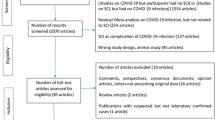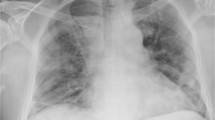Abstract
Study design
Cohort study of patients with spinal cord injury (SCI).
Objectives
To describe the clinical and analytical features of a coronavirus disease 2019 (Covid-19) infected cohort with SCI to enable accurate diagnosis and to outline prevention measures.
Setting
This study was conducted at the National Hospital for Paraplegics (Toledo, Spain).
Methods
A cohort analysis of seven patients with SCI infected by Covid-19 was performed. Diagnosis was confirmed with reverse transcriptase polymerase chain reaction (RT-PCR) of nasal exudate or sputum samples. Clinical, analytical, and radiographic findings were registered.
Results
RT-PCR detected COVID-19 infection in all patients, affecting males and people with a cervical level of injury more often (five out of seven). The average delay for diagnostic confirmation was 4 days (interquartile range, 1–10). Fever was the most frequent symptom (six out of seven). The second most common symptom was asthenia (four out of seven), followed by dyspnea, cough, and expectoration (three out of seven for each symptom). The Modified Early Warning System score for Covid-19 severity rating was classified as severe in five out of seven cases. All but one patient showed radiological alterations evident in chest X-rays at the time of diagnosis. All patients recovered gradually.
Conclusion
Our patients with SCI and Covid-19 infection exhibited fewer symptoms than the general population. Furthermore, they presented similar or greater clinical severity. The clinical evolution was not as pronounced as had been expected. This study recommends close supervision of the SCI population to detect early compatible signs and symptoms of Covid-19 infection.
Similar content being viewed by others
Log in or create a free account to read this content
Gain free access to this article, as well as selected content from this journal and more on nature.com
or
Data availability
The main sources of data were the electronic medical records and clinical reports of each one of the patients. The history of recent contact with a confirmed case, the diagnosis time delay, the symptom and signs of onset and evolution, the laboratory and chest X-rays were analyzed. In order to avoid biases and ensure the patients’ data confidentiality, all documents were handled after removing their filiation data. The corresponding author had full access to all data in the study and had final responsibility for the decision to submit for publication.
References
Li Q, Guan X, Wu P, Wang X, Zhou L, Tong Y, et al. Early transmission dynamics in Wuhan, China, of novel coronavirus–infected pneumonia. NEJM. 2020, January. https://doi.org/10.1056/NEJMoa2001316.
Coronavirus COVID-19 Global Cases by the Center for Systems Science and Engineering (CSSE) at Johns Hopkins University (JHU). JHU COVID-19 Resource Center. Johns Hopkins Coronavirus Resource Center. 2020. https://www.arcgis.com/apps/opsdashboard/index.html#/bda7594740fd40299423467b48e9ecf6.
Zhou F, Yu T, Du R, Fan G, Liu Y, Lui Z, et al. Clinical course and risk factors for mortality of adult inpatients with COVID-19 in Wuhan, China: a retrospective cohort study. Lancet. 2020;395:P1054–62. https://doi.org/10.1016/S0140-6736(20)30566-3.
Sun X, Jones ZB, Chen XM, Zhou L, So KF, Ren Y, et al. Multiple organ dysfunction and systemic inflammation after spinal cord injury: a complex relationship. J Neuroinflammation. 2016;13:260. https://doi.org/10.1186/s12974-016-0736-y.
Shah A, Shem K, McKenna S, BerllyY M. Respiratory management of the spinal cord injured patients. In: Kirshblum S, Campagnolo DI, editors. Spinal cord medicine. Philadelphia: Lippincott Williams & Wilkins; 2011.
Riegger T, Conrad S, Liu K, Schluesener HJ, Adibzahdeh M, Schwab JM. Spinal cord injury-induced immune depression syndrome (SCI-IDS). Eur J Neurosci. 2007;25:1743–7.
Kasinathan N, Vanathi MB, Subrahmanyam VM, Rao JV. A review on response of immune system in spinal cord injury and therapeutic agents useful in treatment. Curr Pharm Biotechnol. 2015;16:26–34.
Prüss H, Tedeschi A, Thiriot A, Lynch L, Loughhead SM, Stutte S, et al. Spinal cord injury-induced immunodeficiency is mediated by a sympathetic-neuroendocrine adrenal reflex. Nat Neurosci. 2017;20:1549–59. https://doi.org/10.1038/nn.4643
Arévalo-Martin A, Grassner L, García-Ovejero D, Paniagua-Torija B, Barroso-García G, Mach O, et al. Elevated autoantibodies in subacute human spinal cord injury are naturally occurring antibodies. Front Immunol. 2018;9:2365. https://doi.org/10.3389/fimmu.2018.02365.
Kopp MA, Watzlawick R, Martus P, Failli V, Finkenstaedt FW, Chen Y, et al. Long-term functional outcome in patients with acquired infections after acute spinal cord injury. Neurology. 2017;88:892–900.
Stillman MD, Capron M, Alexander M, Longini Di Giusto M, Scivoletto G. COVID-19 and spinal cord injury and disease: results of an international survey. Spinal Cord Ser Cases. 2020;6:21.
Righi G, Del Popolo G. COVID-19 tsunami: the first case of a spinal cord injury patient in Italy. Spinal Cord Ser Cases. 2020;6:22.
American Injury Association. International standards of neurological classification of spinal cord injury. Richmond, VA: American Injury Association; revised 2019.
Protocolo de actuación frente a casos de infección por el Nuevo Coronavirus (SARS-CoV-2). Ministerio de Sanidad. Gobierno de España. 2020. https://www.mscbs.gob.es/profesionales/saludPublica/ccayes/alertasActual/nCovChina/documentos/Procedimiento_COVID_19.pdf.
Zu ZY, Jiang MD, Xu PP, Chen W, Ni QQ, Lu GM, et al. Coronavirus disease 2019 (COVID-19): a perspective from China. Radiology. 2020:200490. https://doi.org/10.1148/radiol.2020200490.
Subbe C, Kruger M, Rutherford P, Gemmel L. Validation of a modified early warning score in medical admissions. QJM. 2001;94:521–6.
Lim WS, van der Eerden MM, Laing R, Boersma WG, Karalus N, Town GI, et al. Defining community acquired pneumonia severity on presentation to hospital: an international derivation and validation study. Thorax. 2003;58:377–82.
Guan WJ, Ni Zy, Hu Y, Liang WH, Ou CQ, He JX, et al. Clinical characteristics of coronavirus disease 2019 in China. N Engl J Med. 2020. https://doi.org/10.1056/NEJMoa2002032.
Fauci AS. Covid-19—navigating the uncharted. N Engl J Med. 2020;382:1268–9. https://doi.org/10.1056/NEJMe2002387.
Huang C, Wang Y, Li X, Ren L, Zhao J, Hu Y, et al. Clinical features of patients infected with 2019 novel coronavirus in Wuhan, China. Lancet. 2020;395:497–506.
Acknowledgements
Dr Julian Taylor (JTG) revised the paper and reviewed the English version (julian.taylor@jtgconsulting.org).
Author information
Authors and Affiliations
Contributions
MRC was responsible for designing the clinical protocol and collecting clinical and analytical data, conducting the research, analyzing data, interpreting results, and writing the paper. IJV was responsible for designing the clinical protocol and collecting clinical and analytical data. FGH was responsible for designing the clinical protocol and collecting clinical and analytical data. ELD was responsible for designing the clinical protocol and collecting clinical and analytical data, identifying bibliographic resources, analyzing data, interpreting results, and writing the paper. CGM was responsible for designing the clinical protocol and conducting the research. EVB was responsible for designing the clinical protocol and collecting clinical and analytical data. AGA was responsible for designing the clinical protocol, reviewing data quality, conducting the research, analyzing data, interpreting results, and writing the paper.
Corresponding author
Ethics declarations
Conflict of interest
The authors declare that they have no conflict of interest.
Ethical approval
We certify that all applicable institutional and governmental regulations concerning the ethical use of human volunteers were followed during the course of this research. The guidelines of the declaration of Helsinki were followed in every case and the study design was approved by the local ethics committee (Hospital Virgen de la Salud, Toledo, Spain, resolution number 504).
Informed consent
All participants provided their informed consent.
Additional information
Publisher’s note Springer Nature remains neutral with regard to jurisdictional claims in published maps and institutional affiliations.
Rights and permissions
About this article
Cite this article
Rodríguez-Cola, M., Jiménez-Velasco, I., Gutiérrez-Henares, F. et al. Clinical features of coronavirus disease 2019 (COVID-19) in a cohort of patients with disability due to spinal cord injury. Spinal Cord Ser Cases 6, 39 (2020). https://doi.org/10.1038/s41394-020-0288-3
Received:
Revised:
Accepted:
Published:
DOI: https://doi.org/10.1038/s41394-020-0288-3
This article is cited by
-
COVID-19 and spinal cord injury: clinical presentation, clinical course, and clinical outcomes of people hospitalised
Spinal Cord Series and Cases (2024)
-
Clinical profile of COVID-19 infection among persons with spinal cord injury: a case series
Spinal Cord Series and Cases (2023)
-
Living with spinal cord injury during COVID-19: a qualitative study of impacts of the pandemic in Nepal
Spinal Cord (2022)
-
Clinical features and prognosis of COVID-19/SARS-CoV-2 infections in persons with spinal cord injury: a review of current literature
Spinal Cord Series and Cases (2021)
-
Spinal cord dysfunction after COVID-19 infection
Spinal Cord Series and Cases (2020)



